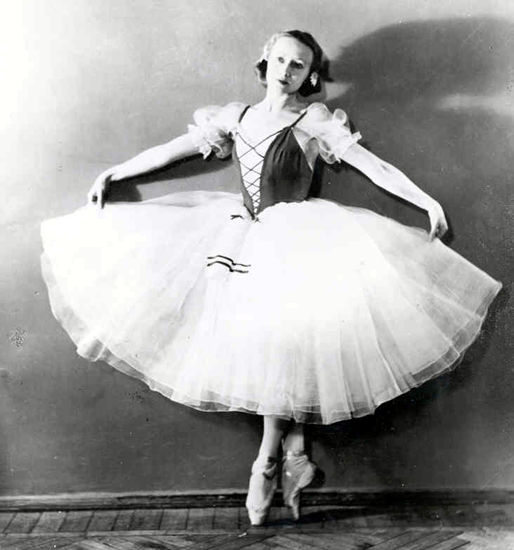Galina Ulanova (1910-1998)

Ulanova wrote a small book, The Making of a Ballerina, and it was translated from the Russian by S. Rosenberg in 1950. The first paragraph reads, "I did not really wish to be a ballet dancer. True, my first visit to the theatre fired my imagination, but I was not swept off my feet by that strong impulse for a stage career which precipitated so many to the footlights."
The first performance she saw was, of course, a ballet. Ulanova's father, Serge Ulanov régisseur of the Imperial Maryinsky Theatre in St. Petersburg, took her to see Sleeping Beauty. At the first appearance of the Lilac Fairy she screamed out, "That's mama, my mama!" Ulanova's mother, Maria Romanova, was a dancer and a teacher at the Imperial School.
After the 1917 Revolution life was difficult for all. Ulanova's parents had to perform three times a day for film audiences as the films were being rewound, in addition to their performances at the Maryinsky.
Ulanova wept bitterly when she was taken by strangers to the Petrograd School of Choreography as a boarding student. Her parents found it necessary because their rehearsing, performing and teaching schedule did not give them the opportunity to care for her. At the school her mother was her first teacher, but Galina didn't want to dance. She had a clear picture of her mother changing from clumsy felt boots to her toe shoes, wearing a crisp tarlatan tutu and performing with a smile. The smile didn't deceive her, "I saw clearly how fatigued mother was and the strain it cost her to dance."
At Ulanova's first lesson at the school she pleaded with her mother to take her home, but her mother told her if she would stay until the New Year she could then come home. The New Year arrived, but since Ulanova had made friends at the school, she decided to stay. She also was making extraordinary progress in her classes. She was invited to perform at the Academic Opera as a little bug in Riccardo Drigo's Caprices of a Butterfly. This debut gave her her first performing experience onstage. It also gave her joy at the thought that, "thank goodness," she had made no mistates. Her next role was that of a bird in Rimsky-Korsakov's Snow Maiden.
She danced the lead in Chopinana at her graduation performance -- and her debut in the theatre was Princess Florine in the Blue Bird variation. At the age of eighteen, four months after her debut, Ulanova danced the leading role of Odette-Odile in Swan Lake. Ulanova said of her early performances: "I danced without deeply understanding the characters I impersonated."
After her studies in the school under her mother's directions, Aggripina Vaganova took over her training. Vaganova was significant in her development as a dancer.
Eventually, Ulanova started to have a social life with the intellectuals of her time. After performances they would gather at a someone's home and discuss all the arts. She was fascinated by the theories of Konstantin Sergeyevich Stanislavsky and applied his ideas to her dancing. She claimed that she had danced Swan Lake a hundred times before she understood the ballet beyond the steps.
Ulanova was much admired for the poetry and dramatic projection of her dancing. But she was also a hard worker. She said, "A dancer must be a hard plodder. Daily practice is the meat and drink and it must never cease, not even during summer holidays." She also danced often at the Bolshoi in Moscow and in 1944 left the Kirov to become the Prima Ballerina of the Bolshoi Ballet. Besides the classical repertory, she created roles in: Fountain of Bakhchisaray (1933), Lost Illusion (1935), and Romeo and Juliet (1940), Tao-Hoa in a revised version of the Red Poppy (1949) and Katrina in the Stone Flower (1954).
In 1945, she danced her first appearance in the West in Vienna. Because of her close connection with the Communist party she danced in Rome in 1949, and Florence and Venice in 1951. Russia at the time had the Iron Curtain and very few artists were allowed in the West. With the Bolshoi Ballet she danced in London (1956) and New York (1959). I was fortunate to have seen her dance in America.
Those who did not have the chance to see her in person could have seen her films in the Art Houses of the West: excerpts from Swan Lake and The Fountain of Bakhchisaray (1953), Romeo and Juliet (1957), and Giselle (her Dying Swan was added as an extra) (1957).
Arnold L. Haskell, dance educator, wrote about Ulanova, "My memories of Ulanova are, to me, a part of life itself, bringing a total enrichment of experience. To me, hers are not theatrical miracles but triumphs of human spirit. Where Pavlova was supremely conscious of her audience and could play upon its emotions as upon an instrument, Ulanova is remote in a world of her own -- which we are privileged to penetrate. She is so completely identified with the character she impersonates that nothing outside exists."
Ulanova retired from the stage in 1962 but continued to work at the Bolshoi Ballet as ballet mistress. Joseph Stalin awarded her the Stalin Prize in 1941, 1946, 1947 and 1951; People's Artist of R.S.F.S.R. (1951); and the Lenin Order (1974).
Another great Soviet ballerina, Maya Plisetskaya, wrote of her colleague, "She was an angel and she danced like one."
A book that you should see called Days With Ulanov by Albert E. Kahn is available at the Lincoln Center Library, Dance Collection.
(First published May 1998)